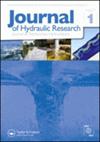变量重构对浅水方程放大解精度和计算性能的影响
IF 1.7
3区 工程技术
Q3 ENGINEERING, CIVIL
引用次数: 0
摘要
本文提出了一种新的子网格洪水淹没模型,该模型通过升级浅水方程(SWE)来提高模型在大规模问题中的效率。该模型使用两个嵌套网格离散化研究领域。方程在粗网格上通过二阶精确空间(即变量的分段线性重建)Godunov型有限体积(FV)方法求解,而细网格用于将高分辨率地形和粗糙度纳入求解中。将该模型的精度和性能与作者最近提出的一阶模型和使用人工和真实世界测试问题的二阶传统FV模型进行了比较。结果表明,该模型提高了精度,在低分辨率网格中,数值格式变量的空间重构对求解精度起着重要作用。本文章由计算机程序翻译,如有差异,请以英文原文为准。
Effects of reconstruction of variables on the accuracy and computational performance of upscaling solutions of the shallow water equations
This paper presents a new sub-grid flood inundation model obtained by upscaling the shallow water equations (SWE) to enhance the model efficiency in large-scale problems. The model discretizes study domains using two nested meshes. The equations are solved at the coarse mesh by a second-order accurate in space (i.e. piecewise linear reconstruction of variables) Godunov-type finite volume (FV) method, while the fine mesh is used to incorporate high-resolution topography and roughness into the solution. The accuracy and performance of the model were compared against a first-order version of the model recently proposed by the authors and a second-order conventional FV model using artificial and real-world test problems. Results showed that improved accuracy is delivered by the proposed model, and that at low-resolution meshes, the spatial reconstruction of variables of the numerical scheme plays a major role in the solution's accuracy.
求助全文
通过发布文献求助,成功后即可免费获取论文全文。
去求助
来源期刊

Journal of Hydraulic Research
工程技术-工程:土木
CiteScore
4.90
自引率
4.30%
发文量
55
审稿时长
6.6 months
期刊介绍:
The Journal of Hydraulic Research (JHR) is the flagship journal of the International Association for Hydro-Environment Engineering and Research (IAHR). It publishes research papers in theoretical, experimental and computational hydraulics and fluid mechanics, particularly relating to rivers, lakes, estuaries, coasts, constructed waterways, and some internal flows such as pipe flows. To reflect current tendencies in water research, outcomes of interdisciplinary hydro-environment studies with a strong fluid mechanical component are especially invited. Although the preference is given to the fundamental issues, the papers focusing on important unconventional or emerging applications of broad interest are also welcome.
 求助内容:
求助内容: 应助结果提醒方式:
应助结果提醒方式:


